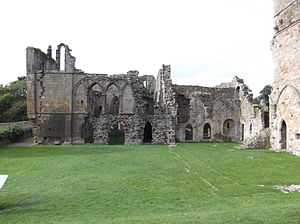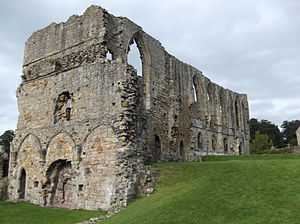Easby Abbey
| Easby Abbey | |
|---|---|
| Abbey of St Agatha | |
|
Easby Abbey refectory | |
| 54°23′52″N 1°43′01″W / 54.39778°N 1.71694°WCoordinates: 54°23′52″N 1°43′01″W / 54.39778°N 1.71694°W | |
| Location | Richmond, North Yorkshire |
| Country | England |
| Denomination | Premonstratensian |
| Website |
www |
| History | |
| Founded | 1152 |
| Founder(s) | Roald, Constable of Richmond Castle |
| Dedication | St Agatha |
| Architecture | |
| Status | Ruin |
| Specifications | |
| Materials | Stone |

Easby Abbey or the Abbey of St Agatha is an abandoned Premonstratensian abbey on the eastern bank of the River Swale on the outskirts of Richmond in the Richmondshire district of North Yorkshire. The site is maintained by English Heritage and can be reached by a riverside walk from Richmond Castle.
The Abbey of St. Agatha, Easby, was founded in 1152 by Roald, Constable of Richmond Castle.[1] The inhabitants were canons rather than monks. The Premonstratensians wore a white habit and became known as the White Canons.[2] The White Canons followed a code of austerity similar to that of Cistercian monks. Unlike monks of other orders, they were exempt from episcopal discipline. They undertook preaching and pastoral work in the region (such as distributing meat and drink).
Other former Premonstraterian houses in the north of England include Egglestone Abbey in County Durham and Shap Abbey in Cumbria. Like most northern monasteries, Easby suffered from frequent Scottish raids during the Middle Ages. Ironically, great damage was caused to Easby and Egglestone Abbey in 1346 when the English army was billeted there on its way to the Battle of Neville's Cross.
In the late 1530s Henry VIII dissolved the monasteries. The abbey was abandoned and left to fall into ruins, though some of the best features were salvaged: the fine canopied choir stalls are now found in Richmond parish church.
St. Agatha's Church (Easby Church)
St. Agatha’s Church (also called Easby Church)[2] is located outside of Richmond, Yorkshire, and can easily be reached from Richmond via the trail alongside the river. The exact foundation date of Easby Church is unknown, but it is thought to predate the neighboring abbey. Little of the original church remains. St. Agatha’s retains medieval frescoes that were preserved through the Reformation after being whitewashed. The church and abbey are open free of charge to the public.
In Easby Church is a plaster replica of the carved stone Easby Cross. The original, which dates from the late 8th or early 9th century, is now in the Victoria and Albert Museum.
The survival of this extremely rare early Christian cross is remarkable because when the church was being renovated the cross was broken up and used as convenient building stone in the new church. It was preserved there until it was found in the wall of the church and reassembled in the 20th century.
Picture gallery of St. Agatha's Church
-
St. Agatha's Church, 19 May 2007
-
Fresco at St. Agatha's
-
Fresco at St. Agatha's
See also
References
| Wikimedia Commons has media related to Easby Abbey. |
| Wikimedia Commons has media related to St. Agatha's Church (Easby Church). |
- ↑ "Easby Abbey | English Heritage". english-heritage.org.uk. Retrieved 6 June 2014.
- ↑ 2.0 2.1 "Online Guide to Richmond - St Agatha's Abbey, Easby". Richmond Online. 2008. Retrieved 15 June 2008.



